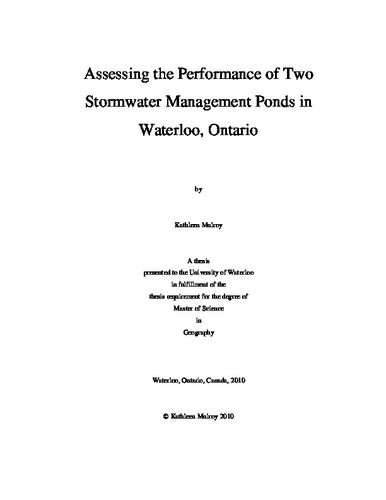| dc.description.abstract | Stormwater (SW) runoff in urban areas represents a major pathway for pollutant transfer to receiving waters. Best management practices (BMP) were introduced in the 1970s to help mitigate the negative effects of SW. In the 1990s, Stormwater management (SWM) ponds were established as a BMP to help increase the water quality of SW effluent. Many SWM ponds do not provide sufficient water quality treatment. Information on the internal processes influencing the reduction of total phosphorus (TP), soluble reactive phosphorus (SRP) and total suspended solid (TSS) concentrations in SWM ponds with different designs is lacking. Knowledge of the processes affecting TP, SRP and TSS retention can help improve the design of SWM ponds to enhance their treatment performance.
The purpose of this thesis is to provide an assessment of the internal chemical processes that affect the trap efficiency (TE) and spatial and temporal variability of TP, SRP and TSS concentrations at two structurally different SWM ponds (Pond 45; conventional and Pond 33; hybrid extended detention) in Waterloo, ON. Water samples were collected at the inflow and outflow at the two SWM ponds during six storm events and 30 baseflow periods. A mass balance approach was used to quantify the TE of TP, SRP and TSS concentrations at each pond. Pond 33 had a TE of 24.3%, 26.7% and 66.8% for baseflow and stormflow samples of TP, SRP and TSS. Pond 45 performed much better with TE of 93.8%, 94.2% and 98% for TP, SRP and TSS concentrations. Pond 33 was a source of TP, SRP and TSS for 3, 4 and 2 storm events sampled during the field season, respectively. Pond 45 was a sink for all parameters on all storm events samples.
The spatial and temporal variability of TP, SRP and TSS concentrations were examined to improve knowledge of external factors and internal processes that influence the TE of SWM ponds. The effects of storm magnitude, seasonality and vegetation growth and senescence on effluent water quality were investigated. Additionally, the role of sediment on P cycling in the ponds was evaluated by determining grain size distribution, porewater SRP concentrations, sediment geochemistry and mineralogy, and the sediment P buffering capacity. Vegetation senescence, anoxic conditions, porewater SRP concentrations, sediment characteristics and buffering capacity influenced the poor TE at Pond 33. Pond 45 had more favourable water column conditions, i.e. higher dissolved oxygen concentrations, therefore allowed greater amounts of P to adsorb onto sediment. Design and maintenance considerations are described to help improve the performance at Pond 33. Continual water quality monitoring of SW effluent will identify changes in quality and mitigation measures can be implemented to increase a SWM ponds performance. | en |

